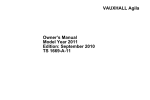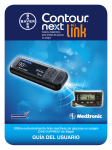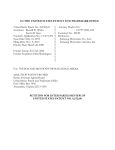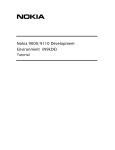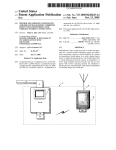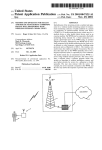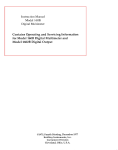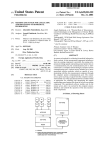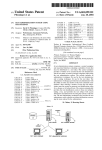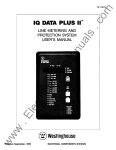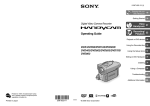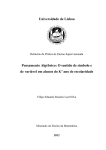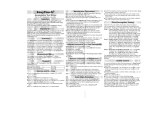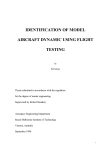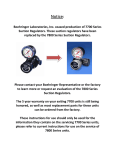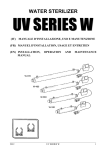Download Method and apparatus for health and disease management
Transcript
US006976958B2 (12) United States Patent (10) Patent N0.: (45) Date of Patent: Quy (54) METHOD AND APPARATUS FOR HEALTH AND DISEASE MANAGEMENT COMBINING PATIENT DATA MONITORING WITH WIRELESS INTERNET CONNECTIVITY (75) Inventor: Roger J. Quy, Mill Valley, CA (US) (73) Assignee: Q-Tec Systems LLC, Wilmington, DE (Us) (*) Notice: Subject to any disclaimer, the term of this patent is extended or adjusted under 35 U.S.C. 154(b) by 75 days. (21) Appl. No.: 10/773,501 (22) Filed: Feb. 6, 2004 (65) Prior Publication Data FOREIGN PATENT DOCUMENTS JP W0 W0 W0 W0 W0 W0 W0 W0 W0 W0 W0 W0 W0 W0 W0 W0 2002344660 A WO WO WO WO WO WO WO WO WO WO WO WO WO WO WO WO Continuation-in-part of application No. 10/418,845, ?led on 09/738,270, ?led on Dec. 15, 2000, now Pat. No. 6,602,191. Int. Cl.7 ............................ .. A61B 5/00; H04N 7/06 us. Cl. ................ .. 600/301; 340/539.12; 128/903; 128/904; 725/116 Field of Search ............................... .. 600/300, 301, 600/345, 365, 481, 483, 485, 509, 529; 607/27, 60, 30—32; 128/903—905, 920; 348/1401; 725/116, 131; 705/2 (56) References Cited U.S. PATENT DOCUMENTS 4,282,883 A 8/1981 Yerushalmy 5,012,814 A 5,307,263 A 5,357,427 A 5/1991 Mills et al. 4/1994 Brown 10/1994 Langen et al. 5,434,611 A 5,441,047 A * 7/1995 Tamura .................... .. 725/116 8/1995 David 61 al. (Continued) * 11/2002 ............... .. 725/116 11/1995 8/1997 8/1997 6/1998 9/1998 2/1999 3/1999 8/1999 9/1999 9/1999 6/2000 7/2000 9/2000 9/2000 10/2000 4/2001 Helsinki University of Technology (Department of Com puter Science and Engineering) Nov., 2000. (Continued) Apr. 18, 2003, which is a continuation of application No. (58) 95/32480 97/28736 97/28737 98/24358 98/38909 99/04687 99/14882 99/41682 99/44494 99/46718 00/36900 00/40145 00/54205 00/54206 00/62662 01/24038 U.S. Appl. No. 60/264,739, ?led Jan. 2001, Posa et al. Jyrki Oraskari ; “Bluetooth versus WLAN IEEE 802.11X”; Related US. Application Data (51) (52) Dec. 20, 2005 OTHER PUBLICATIONS US 2004/0162466 A1 Aug. 19, 2004 (63) US 6,976,958 B2 Primary Examiner—Willis R. Wolfe, Jr. (74) Attorney, Agent, or Firm—Mark D. WiecZorek (57) ABSTRACT Embodiments of the invention provide a method and appa ratus for a Wireless health monitoring system for interac tively monitoring a disease or health condition of a patient by connecting an internet-enabled Wireless Web device (“WWD”) to a digital camera or other health monitoring device. The WWD may accommodate a memory device for enhanced storage capabilities that may be particularly per tinent to data-intensive tasks such as the handling and storage of images or other visual data. The health related data is transmitted from the WWD to a server using standard internet protocols and may be integrated With various oper ating systems for handheld or Wireless devices, especially those With enhanced capabilities for handing images and visual data. 17 Claims, 12 Drawing Sheets US 6,976,958 B2 Page 2 US. PATENT DOCUMENTS 5,544,649 A * 5,544,661 A 5,549,117 A 5,553,609 A * 5,601,435 A 5,626,144 5,678,562 5,701,904 5,704,366 5,724,025 5,732,709 5,735,285 5,752,917 5,772,586 5,791,342 5,931,791 5,933,136 5,935,060 5,941,829 5,951,300 5,959,533 5,964,701 8/1996 David et al. .............. .. 600/301 8/1996 Davis et al. 8/1996 Tacklind et al. A A A A A A A A A A A A A A A A A 9/1996 Chen et al. ............... .. 600/301 2/1997 Quy 5/1997 10/1997 12/1997 1/1998 3/1998 3/1998 4/1998 5/1998 6/1998 8/1998 8/1999 8/1999 8/1999 8/1999 9/1999 9/1999 10/1999 Tacklind et al. Sellers Simmons et al. Tacklind et al. Tavori Tacklind et al. Albert et al. Fuchs Heinonen et al. Woodard SaltZstein et al. Brown Iliff SaltZstein et al. Brown Layson et al. Asada et al. 5,967,975 A 10/1999 Ridgeway 5,987,352 5,987,519 5,997,476 6,022,315 6,024,699 6,050,940 A A A A A A 11/1999 11/1999 12/1999 2/2000 2/2000 4/2000 Klein et al. Peifer et al. Brown Iliff Surwit et al. Braun et al. 6,055,506 6,057,758 6,059,692 6,083,156 6,101,478 6,144,837 A A A A A A 4/2000 5/2000 5/2000 7/2000 8/2000 11/2000 Frasca, Jr. Dempsey et al. Hickman Leseicki Brown Quy 6,160,478 A 6,168,563 B1 6,190,324 B1 6,266,645 B1 6,319,199 B1 6,336,900 B1 6,375,614 B1 7/2002 Kumar et al. 6,418,346 B1 * 7/2002 Nelson et al. 6,440,068 6,450,955 6,458,080 6,529,771 B1 B1 B1 B1 6,602,191 B2 2002/0016719 2002/0019584 2002/0026223 2002/0072785 2002/0082480 2002/0120310 2003/0004554 2003/0072424 2003/0139785 2003/0204413 A1 A1 A1 A1 A1 A1 A1 A1 A1 A1 8/2002 9/2002 10/2002 3/2003 Brown Brown Brown Kieval et et et et lators ; http:/biZ.yahoo.com/prneWs/001012/moi mallinc.html; 1 page; Nov. 24, 2000. Bluetooth Wireless technology—bridging the gap between computing and communication; Bluetooth Technology; http://WWW.intell.commobile/bluetooth/; 2 pages; Nov. 28, 2000. Bluetooth resource center ; What is Bluetooth ?; paloWire less.com; http:/WWW.paloWireless.com/infotooth/Watis.asp; 3 pages; Nov. 28, 2000. Bluetooth Tutorial ; paloWireless.com—bluetooth resource center ; http://WWW.paloWireless.com/infortooth/tutori al.asp; 4 pages; Nov. 28, 2000. Bluetooth Pro?les; paloWireless.com—bluetooth resource http://WWW.paloWireless.com/infortooth/tutorial/ http://WWW.cellular.com.Za/bluetoothi802.htm; 4 pages; Nov. 28, 2000. Bluetooth vs. Airport (802.11 NetWork); paloWireless. com—Bluetooth resource center; http://WWW.paloWireless. com/infotooth/knoWbase/othernetWorks/15.asp; 3 pages; Nov. 28, 2000. Personal Digital Assistants; A2 Anytime/AnyWhere—A Weekly on Wireless Infrastructure and Data Services; Tho mas Weisel Partners (Merchant Banking); 5 pages; Nov. 29, .............. .. 607/30 al. al. al. al. 8/2003 Quy 2/2002 2/2002 2/2002 6/2002 6/2002 8/2002 1/2003 4/2003 7/2003 com ; 2 pages ; Nov. 24, 2000. About Data Critical Corporation ; Yahoo—Data Critical to Provide Mallincrodt With Wireless Connectivity for Venti Nick Hunt ; Bluetooth Venus 802.11 ; TDK Systems ; 7/2001 Simpson 6,416,471 B1 ogy ; Amira ; httpz/amira.com/tech/tcitechhtm; 2 pages; Nov. 24, 2000. Wired for Wellness ; LifeChart.com ; http:/WWW.lifechart. center; 11/2001 Sheehan et al. 1/2002 Alleckson et al. 4/2002 Braun et al. 5/2002 Lindberg Technology & Clinical Results—Simple Solutions Through Technology—Progression of Glucose Monitoring Technol pro?les/asp; 4 pages; Nov. 28, 2000. 12/2000 Jacobsen et al. 1/2001 Brown 2/2001 Kieval et al. 6,386,882 B1 Painless Blood—Glucose Monitoring ; KumertriX Technol ogy OvervieW ; http:/WWW.kumertriX.com/technology.html; 2 pages; Nov. 24, 2000. Nemeth et al. SchultZe et al. Riff et al. Nelson et al. Riff et al. Linden et al. Riff et al. Evans et al. Riff et al. 10/2003 Riff 2000. Ashlee Vance; Ericsson and Intel Make Bluetooth Pact; InfoWorldcom; http://WWW.infoWorld.com/articles/hn/Xml/ 00/ 12/04/001204hnericintel.Xml? T. . ./printarticle .htm; page; Dec. 4, 2000. 1 Personal Portable Of?ce; Nokia 9000il digital; http://WWW. nokiausa.com/9000il; 4 pages; Dec. 7, 2000. Pui—Wing Tam; Handspring Homes; Article from the Wall Street Journal; Section B; Nov. 2000. Author unknoWn; Articles on Phones and NeW Technolo gies; Article from the Wall Street Journal; Nov. 2000. David Pringle; Sagen to Launch Hand—held Computer that Doubles as Top—End Mobile Phone; Article from the Wall Street Journal; Nov. 2000. Svensson, Peter; “Cisco Launches WiFi Phone” Article from Australian IT; Apr. 29, 2003. “Breakthrough Devices ShoWn At ADA” published in Dia betes NeWs for Jul. 1, 2001 at http://WWW.diabetesnet.com/ neWs/neWs070101.php. “iMetrikus” published at http://WWW.qualcomm.com/qWbs/ OTHER PUBLICATIONS Jack Smith ; Your Personal Health Buddy; ABCNeWs.com; http:/abcneWs.go.com/sections/tech/CuttingEdge/ cuttingedge990225.html; 3 pages (Nov. 24, 2000). resource/resourcelib casestdy.shtml. “Applications of MedStar” published on Apr. 27, 2003 by Cybernet Medical, 16 pages. “HIPAA & WiFi: Regulatory Tangles for Wireless Health Care NetWorks Analyzed” published at http://WWW.hipaad The Health Hero Communications Platform ; The Health Hero Network Online Services ; http:/WWW.hhn.com/prod visory.com/tech/Wireless.htm. ucts/indeX.html ; 2 pages (Nov. 24, 2000). http://WWW.medtronic.com/carelink/features.html. “Medtronic CareLink NetWork, HoW It Works” published at US 6,976,958 B2 Page 3 “FDA Approves Medtronic CarelinkTM Monitor and Soft Ware, Opening a NeW Chapter in Patient Management Using Internet Technology”, Medtronic News Release dated Jan. 2, 2002. “iMetrikus Mobile Solutions” brochure by iMetrikus, Inc. “InstromediX—Products” published at WWW.instromediX. com/pages/products/products.asp. 7 Pages. “The MedStar System, HoW the MedStar System Works” brochure published by Cybernet Medical. * cited by examiner U.S. Patent Dec. 20,2005 Sheet 1 0f 12 US 6,976,958 B2 Fm .GEF U.S. Patent Dec. 20,2005 Sheet 2 0f 12 1' cantosW3-5:m.0M2 a I.‘ l' US 6,976,958 B2 U.S. Patent Dec. 20,2005 Em Sheet 3 0f 12 US 6,976,958 B2 or 52 m. Wtorm-.:45 6Em 29. U.S. Patent 4| \ (5:.35 02.30 Dec. 20,2005 m "zuzmw .1Hr. m.5 52 ‘godizu=.<03“t 25m» .$2503L Sheet 5 0f 12 82.56 .50 US 6,976,958 B2 "“SE R m“@83E0:?» ".2 m V . 02985. “l.2053}:85» 4..9tu:suFom§ch_2uwm0?xh B52.%2:05 : 1K3.2OmgKNEP“ ?womza2u .c?Janm>aBt9u0-E35‘ 3 2>m :> 5. 0.3 50: .um?EFnob? oz : . 350.2 8'Es; ".a4‘5 :5 "9.54 0mOE 95.2 0:35. 8F .um»: i52 52m “2. 7 m20:35E2.n0w‘:»m5.23m . HA320.35 5"25%0‘“ m .23' .J U.S. Patent |‘:5 <En._5w§m $.5K2B905 "wagon Dec. 20,2005 m 5 ...m5.I 52 @645 \.JR.53 .cL.a.n Iwnzolum m"nu52m. 20:63; 526» m203.9 "E513w25a9.31 ‘J2w0.1 -45 If:at; a“ir| n. n251% m530 Sheet 6 6f 12 "5.25. A“:rL m593ml» US 6,976,958 B2 m.amino: [email protected]’m08 .2.m zo.gm . m$e2.n5um ‘w mo a 5 (1 5m: i025. D; on" _mNN __31.5801 8:_36am U.S. Patent Dec. 20,2005 Sheet 7 0f 12 US 6,976,958 B2 U.S. Patent Dec. 20,2005 Sheet 9 0f 12 FIG. 9 244 \ f J‘ [:1 224 US 6,976,958 B2 U.S. Patent Dec. 20,2005 Sheet 10 0f 12 US 6,976,958 B2 FIG. 10 HMD 260 f0 /21 25 24; U.S. Patent Dec. 20,2005 Sheet 11 0f 12 US 6,976,958 B2 PATIENT PRESENTS WITH MALADY 202 FIG. 11 MEDICAL PERSONNEL ARRIVE ON SCENE AND WWD IS ENGAGED 204 PERSONNEL ‘ TAKES l A ACTION 206 VISUAL DATA CAPTURED OF PATIENT AND/OR ' HMD IS ATTACHED TO PATIENT 210 STORED ON MEMORY DEVICE ‘ 208 HMD DATA CAPTURED OP PATIENT AND/OR STORED ON MEMORY DEVICE 212 VISUAL DATA, NETWORK AVAILABLE 7 220 NO OPTIONALLY WA“ FOR : TRANSFORMED, IS SENT WIRELESSLY TO 218 INTERNET FOR REVIEW BY PHYSICIAN, WHO ADVISES PERSONNEL OF NEEDED ACTIONS 214 AVAILABLE NETWORK YES STORE DATA ON MEMORY DEVICE IF NOT ALREADY STORED 216 U.S. Patent Dec. 20,2005 Sheet 12 0f 12 US 6,976,958 B2 FIG. 12 INSERT MEMORY DEVICE IN WWD DOWNLOAD APPLICATION DOWNLOAD VISUAL DATA FROM MEMORY FROM MEMORY DEVICE AND DISPLAY DEVICE INTO WWD 272 ON WWD 274 US 6,976,958 B2 1 2 Even With the advantages provided, these systems limited METHOD AND APPARATUS FOR HEALTH AND DISEASE MANAGEMENT COMBINING PATIENT DATA MONITORING WITH WIRELESS INTERNET CONNECTIVITY the user to location in Which the device Was located. Even Where devices are portable, as in the case of a laptop computer With a modem, an ordinary POTS phone line must be found and used. Where the user’s computer employs a broadband connection, such as DSL or satellite, the choices CROSS-REFERENCE TO RELATED APPLICATIONS of location are even more limited. Attempts have been made to remedy this de?ciency. For example, many telemetry systems alloW a “Wireless” dis This application is a continuation-in-part of US. patent application Ser. No. 10/418,845, ?led Apr. 18, 2003, Which tance to be placed betWeen a health measuring unit and a is a continuation of US. patent application Ser. No. 09/738, 270, ?led Dec. 15, 2000, now US. Pat. No. 6,602,191. remote monitoring system. HoWever, such systems are lim ited in their range. REFERENCE TO GOVERNMENTAL SUPPORT (none) 15 REFERENCE TO MICROFICHE APPENDIX US. Pat. No. 5,772,586, issued Jun. 30, 1998 to Heinonon et al., discloses a method for monitoring the health of a patient. This system uses a specialiZed connection betWeen (none) FIELD OF THE INVENTION 20 The present invention relates to monitoring of living subjects, and more particularly to health-monitoring of running on an internet-connected server and Where the same 25 may be studied and processed by the softWare application, a health professional, or the subject. 30 With the patient. Instead, such systems, if internet-enabled, are often limited to mere one-Way non-interactive data transfer via a modem. While some systems are more ef?cient interactive communication of medical or health information betWeen a subject or patient and a revieWer or enhanced, including that disclosed in US. Pat. No. 5,357, 427, issued Oct. 18, 1994 to Langen, et al., and entitled provider of that information. In particular, communication Medical or health information has been made available on communication bus of the mobile phone. Other systems have been proposed, but these suffer from similar de?cien cies in that they are not designed to be used With “off-the shelf” Wireless devices or health measuring equipment. The deployment of the above systems also currently lacks employment of full back-end server functionality With Which to provide a Wide range of interactive communication BACKGROUND OF THE INVENTION of consumer physiological information has been a subject of such attempts. It is noted that in this regard the “revieWer or provider of medical or health information” is understood to include not only a physician but also a softWare application or algorithm that may analyZe the information. the patient health measuring unit and the cellular phone, hoWever. The patient health measuring unit is located in the battery space of the mobile phone and is connected to a persons Where measured or input health data is communi cated by a Wireless device to and from a softWare application Several attempts have been made in the past to achieve Other systems have used cellular telephone technology to increase the Wireless health monitoring range. HoWever, these systems have several de?ciencies, such as requiring signi?cant modi?cation of the mobile phone. For example, 35 “Remote Monitoring of High-Risk Patients using Arti?cial Intelligence”, these systems are limited by the Wired tele communications infrastructure. SUMMARY OF THE INVENTION 40 Embodiments of the present invention overcome one or a CD-ROM accessible by a home computer system. This more of the disadvantages of the prior art by providing a passive approach had certain disadvantages. First, although full-feature health-monitoring system that may Wirelessly the personal computer is prevalent is the United States, it is connect to a back-end server application via the internet. The invention alloWs Wireless access to and from a Wide variety generally too expensive for a consumer physiological moni toring system and there are many people Who ?nd it too complicated to set up and use for that purpose. High-risk, 45 chronically ill patients, responsible for more than half of health care costs in the United States and forming the fastest groWing segment of those requiring health care, are indeed the most likely not to be able to afford or use a system built 50 around a personal computer. In addition, such systems are limited in their interactivity to the information stored on the CD. of present medical or health-related instruments and devices, While maintaining the capability of connecting to future such devices. In particular, the invention may be embodied in several systems. TWo complementary such systems are described herein, although extensions to other such systems can be envisioned. First, an embodiment of the invention may be employed to manage the disease state or condition of a patient. In this embodiment, the patient may employ a health monitoring device (“HMD”), in particular a medical device, Previous patents by the Inventor addressed both of these disadvantages, as Well as the need to reduce health care costs 55 and a Wireless connection to provided data from the medical device for processing via the internet including a revieW by through providing educational health care information and interactive physiological monitoring in the home environ ment by means of a user-friendly, interactive system (see, e.g., US. Pat. Nos. 5,601,435, 6,144,837, and continuations thereof). a physician or other health care professional if required. In the second embodiment, a health or lifestyle manage ment plan may be implemented. Various health parameters, 60 such as those relating to nutrition or exercise, may be These previous patents Were based on a video game console, or a multimedia player using a conventional tele entered into a health monitoring device, in this instance disease management. example, in the ?rst embodiment, a diabetic could connect termed an “exercise machine”, and the same may be Wireless communicated to a server. An application may process and vision screen as the display device to achieve a system store the health parameters, and a health specialist may Which is simpler to use than systems based on a personal computer. An initial embodiment of the previous patents 65 optionally revieW the same. utiliZed a compact disc to provide interactive information for Wireless internet connectivity has many advantages. For US 6,976,958 B2 3 4 a blood glucose meter to an internet-enabled Wireless Web optical techniques including lasers, and other such tech device (“WWD”) away from home and download data to a niques may be used. The patient or subject may also input data manually, such as by a stylus, keypad, synchroniZation Diabetes Management Company’s server and, in response, receive guidance displayed on the screen (or by voice) about from a PC, or by various other techniques discussed beloW. A major advantage of the invention is that by use of an choices for the neXt meal. optional adaptor, the system is compatible With current and Alternatively, in the second embodiment, a person inter ested in tracking an eXercise program may take the WWD to prior HMDs as Well as maintaining a capability of adapting to future such systems. the local health club and attach the same to an eXercise machine, send data output from various eXercise machines Other advantages of the invention may include one or more of the folloWing. An embodiment of the invention may be used When a patient is traveling or otherWise aWay from their “Wired” means of communication. The invention alloWs Wireless health-monitoring to the level of accuracy over the Internet, and receive a personaliZed response from the server of a company specialiZing in Health & Lifestyle Management. The individual may input caloric content of foods eaten, and may further input caloric content of eXer cise performed. In this Way, e.g., a person in a Weight-loss program may see in great detail Whether they are eXpending more calories in the form of eXercise than the same indi previously achieved only by desktop so-called “Wired” 15 vidual is consuming in the form of food. In general, in the health management embodiment, the system may be employed to monitor the physiologic status computer systems. The invention is protocol-independent. The interaction betWeen a WWD and a back-end server may provide a major additional advantage in certain embodiments of the invention. In particular, the relatively of a healthy subject While eating, eXercising, or performing small amount of memory currently provided on a WWD as compared to a back-end server severely limits the function other activities. For clarity, such devices are termed herein “exercise machines”. These may include an electronic body terms of computing capacity, processing poWer, and user Weight scale, a body fat gauge, biofeedback devices, phys iotherapy or chiropractic equipment, blood pressure on the back-end, less memory and processing capabilities recorders, or the like, or any type of eXercise machine or monitor, including a heart rate monitor, treadmill, roWing ality of applications running on the WWD, especially in interface. By providing signi?cant application functionality 25 machine, stepper, or the like. In more detail, the present invention provides a method and system for assisting patients to manage a disease or become necessary on the WWD (i.e., on the “front-end”). Thus, memory may be used in the WWD for an enhanced user interface or for other purposes, according to the user requirements. maintain healthy lifestyle by collecting health-related data In a method according to an embodiment of the invention, the patient connects to a speci?c Internet site and a softWare and providing information in response to those data by program, resident on a remote server located on the Internet, means of a WWD designed to display interactive informa tion through a connection to the Internet. The present invention may be connected to various HMDs, both medical and exercise-related in nature, and may communicate infor doWnloads an interactive user interface for that patient and an application for the measurement of the physiological data. The softWare may also be doWnloaded to the WWD from a personal computer via a synchroniZation operation in knoWn fashion. The softWare provides a personaliZed dis play for the user and con?gures the WWD to control and monitor devices connected via a generic input/output port to the WWD. The softWare may be designed to suit the constraints of the small display screens of WWDs. The softWare, as Well as inputs from the patient or other inputs, can control the manner, content, and display of information presented to the patient, and measured or input data can be stored for revieW by a health care provider or by a softWare mation via a Wireless connection such as a Wireless Internet connection. A major advantage of embodiments of the invention is that the same frees the patient from the constraints of Wired systems. The same alloWs users With consumer “off-the shelf” Wireless devices to signi?cantly eXtend the range of 40 connectivity over that of Wired computer, television, or even Wireless telemetry systems. In a ?rst embodiment of the present invention, the WWD is a Web-enabled mobile phone. Here it is noted that the term 45 “Web” or “internet” are used interchangeably to refer to the internet in general. In a second embodiment, the WWD is a palm, handheld, or laptop computer, or a PDA, equipped With a Wireless modem. In a third embodiment, the WWD may be a hybrid device that combines the functions of a algorithm or application. The algorithm may be of varying complexity, from a simple program that merely acknoWl edges receipt of information to an arti?cial intelligence algorithm, such as an eXpert system, collaborative ?ltering system, rules based system, case-based reasoning system, or other such arti?cial intelligence application. computer, PDA and telephone. Further information may be provided to or from the patient, including information entered manually. The patient An adaptor is used if necessary to convert the output signal of the medical monitoring device to a suitable input signal for the, e.g., WWD. The adaptor alloWs connection of may input this information via a personal computer, Which then may doWnload the input information to the WWD via the WWD to a medical device, eXercise machine or other 55 a synchroniZation operation using standard protocols, such variety of health care equipment, and the connection may be made via several techniques. As for Wired techniques, a standard USB, USB2, FireWire, parallel bus or serial cable may be used if the input/output ports betWeen the HMD and the WWD are appropriate. OtherWise, a suitable separate as those for Palm PDA devices. The user may also input supplemental information via a PC connected independent to the server via the internet. Such supplemental information may include data that is dif?cult or inconvenient to input on the WWD. In this Way, the patient may be afforded a more convenient environment adaptor may be employed. The connection may also be an input such as a disk drive in Which to manipulate data to supplement the data input to or other media input for input of data, a USB port or phone the WWD. The deployment of voice processing technology jack or other such Wired input, again employing an adaptor if required. As for Wireless techniques, infrared (IR), microWaves, radio frequency (RF), e.g., Bluetooth® or 802.11 protocols, may be used to enable an even more convenient user 65 interface: i.e., one to Which patients can talk. In all of these respects, the portable aspect of the WWD is important: to Wit, the user may conveniently carry the US 6,976,958 B2 5 6 W WD on their person Wherever they may go, allowing data entry at the time needed. The term “subject” as used herein primarily indicates a human subject. The same may be a medical patient under physician care, a person interested in maintaining health via accurate recording of nutrition and exercise, and so on. The term “user” is generally used to refer to the user of the device, Which may be synonymous With the subject or may Other aspects, features, and advantages Will be apparent from the summary above, as Well as from the description that follows, including the ?gures and the claims. alternatively be a caregiver of the subject, etc. The term BRIEF DESCRIPTION OF THE DRAWINGS “patient” is used, in addition to a person under the care of a physician, to also refer to a “normal” or healthy individual FIG. 1 illustrates a general embodiment of a Wireless health-monitoring system according to the present inven 10 tion; FIG. 2 illustrates an embodiment of a Wireless health monitoring apparatus according to the present invention, shoWing the system of FIG. 1 up to a point of a Wireless antenna; Who is interested in maintaining a healthy physiologic balance. The term “signal communication” is used to mean any type of connection betWeen components Where the connec tion is, e.g., electromagnetic, and Where the connection 15 FIG. 3 illustrates an embodiment of a back end of a alloWs information to be passed from one component to another. This term may be used in a similar fashion as health-monitoring system according to the present inven “coupled”, “connected”, “information communication”, tion; “data communication”, etc. The folloWing are examples of signal communication schemes. As for Wired techniques, a standard bus or serial cable may be used if the input/output ports are compatible and an optional adaptor may be employed if they are not. As for Wireless techniques, IR, microWaves, RF, e.g., Bluetooth® or 802.11 protocols, opti FIG. 4 illustrates a data How diagram according to an embodiment of the present invention; FIG. 5 illustrates an embodiment of a method of use for a Wireless application and a server application according to the present invention, in Which the same is implemented for disease and patient management; cal techniques including lasers, and other such techniques 25 FIG. 6 illustrates an embodiment of a method of use for a Wireless application and a server application according to the present invention, in Which the same is implemented for health management; type of convention, standard, universal, stock, consumer, or “off-the-shelf” type of port for data input and output. These FIG. 7 illustrates an embodiment of a Wired connection betWeen a HMD and a WWD, also shoWing an optional may include both Wired and Wireless ports. A further adaptor; and description is given beloW. FIG. 8 illustrates an embodiment of a Wireless connection betWeen a HMD and a WWD, also shoWing an optional adaptor. 35 FIG. 9 illustrates an embodiment of a Wireless system for transmitting visual data to and from a user. FIG. 10 illustrates an alternative embodiment of a Wire less system for transmitting visual data to and from a user. FIG. 11 illustrates an embodiment of a method for using a Wireless system to transmit visual data to and from a user. FIG. 12 illustrates an embodiment of a method for using 40 entry of the desired parameters. In general, HMDs include Referring to FIG. 1, a system of the present invention is shoWn for monitoring health data from a patient or subject 38. The system includes a Wireless health-monitoring appa ratus (“WHMA”) 10 described in further detail beloW. WHMA 10 is linked in a Wireless fashion to a Wireless connection point of presence (“POP”) 19, the same includ Wireless (not shoWn) Internet 21, Which may include the 45 DETAILED DESCRIPTION OF THE PREFERRED EMBODIMENTS Various acronyms are used for clarity herein. De?nitions are given beloW. The term “HMD” may encompass not only devices With physiologic sensors but also devices With a keypad, keyboard, mouse, pointer, pressure sensor, or other such inputs that the patient or user may employ to perform data Various embodiments of the invention are noW described in more detail. ing at least a base station antenna 15 coupled to a server 17. Server 17 is in turn connected to the Wired, or even a a memory device to load an application program onto a Wireless system. may be used. The patient or subject may even input data manually, such as by a stylus or keypad or by various other techniques discussed above and beloW. The term “generic input/output port” is used to mean any World Wide Web. Referring to FIG. 2, an ?rst embodiment of WHMA 10 is shoWn. WHMA 10 includes an HMD 11, Which may include an optional monitor screen 40, coupled via an optional adaptor 42 to a WWD 12. WWD 12 connects Wirelessly via an antenna 60 to base station 15 (see FIG. 1). One function of WWD 12 is to provide the user interface; other functions are described beloW. As noted above, HMD 11 may include a physiologic sensor 24 or may include a manual system 36 for input of 55 some means for determining a health parameter. In a disease management embodiment, an HMD may be a blood glucose monitor, a blood pressure monitor, an physiologic data via a connection 34. Manual system 36 may also be used to input data directly into WWD 12 via a connection 32. Manual system 36 may include, e.g., a keyboard 30, a mouse 26, a pen-type device 28, and may also employ a separate monitor (not shoWn). Of course, the ambulatory ECG recorder, a respiratory monitor, a tempera user may also vieW information on monitor 40 or on a screen ture or heart rate monitor, and so on. 41 of WWD 12. In many embodiments, the stylus-based system employed by many current PDA’s, such as the Palm®, may be preferred for such manual data input. In a healthy lifestyle management embodiment, an HMD may be an exercise machine, including treadmills, roWers, steppers, exercise cycles, or other aerobic or anaerobic exercisers, or a monitor, include monitors for temperature, heart rate, blood pressure, amount of Work or rate of Work performed, etc. 65 Data may also be input via entry on a computer 37. This data may then be synchroniZed to WWD 12 in knoWn fashion. Alternatively, computer 37, or another computer (see computer 37‘ in FIG. 4) may be used to connect to a US 6,976,958 B2 7 8 server using the Wired internet. This use may be particularly advantageous When entering a large amount of data, such as protocols, and may be implemented in any languages sup ported by the WWD and server. Of course, as computing a patient’s medical history. As noted above, in this Way the capabilities continue to increase, it is expected that the patient may be afforded a more convenient environment in capabilities of WHMA 10, servers 18 and 22, as Well as Which to manipulate data to supplement the data input to the application 62 and client 44, and other components, Will WWD. It Will be clear to one of skill in the art given this teaching that cable 32, as Well as cables 34 and 44, may be replaced correspondingly increase. With Wireless circuitry to communicate signals Wirelessly. Alternatively, cables 34 or 44 may be replaced by a direct 10 the Wireless Internet connection and intervening pathWays. plug and socket connection. For medical devices and applications, physiologic sensor 24 may include, e.g., a sensor appropriate for measuring blood glucose levels, blood pressure, heart rate, or any other desired parameter as required by the physician. Sensor 24 Application 62 running on server 22 may interact With WHMA 10 in a number of Ways. Referring to FIG. 4, WHMA 10 is shoWn in signal communication With server 22 via a connection 72. Connection 72 schematically represents WHMA 10 includes an application that may be vieWed as having tWo components: a base Wireless or device applica tion 70 and an application presentation layer or user inter 15 face 68. User interface 68 is employed to, e.g., present a menu of options to the user, to alloW the user to choose may connect via an optional cable 44 to subject 38. Alternatively, sensor 24 may be distal of HMD 11, i.e., at or inputs, and to generally operate the device. User interface 68 may vary Widely in sophistication, e.g., from a simple data Within subject 38. In other Words, if cable 44 is employed, sensor 24 may be proximal or distal of cable 44. If a Wireless entry ?eld to a full graphical user interface. These applica communications capability is added, sensor 24 need not physically connect With HMD 11 or WWD 12 at all. That is, tions may accept as inputs data from a sensor 24 as Well as the same may measure a health parameter and may com from a manual input 36. Server 22 has a base server application 62 With Which the municate the same to Wireless health-monitoring apparatus 10 Wirelessly. The short range Wireless communications same calculates or provides a response based at least in part on data from WHMA 10. Application 62 may include an schemes Which may be employed include infrared, radio frequency including Bluetooth or 802.11, or other such 25 algorithm 63 for analyZing data from the HMD, and either application 62 or algorithm 63 may optionally access data from an external data source 74 and may further consult an schemes. As examples of sensor types, to measure blood glucose arti?cial intelligence system 76. External data source 74 may be a memory or disk or other levels, sensor 24 may be a sensor that accepts a drop of blood, e.g., via a ?nger-prick. To measure heart rate, sensor 24 may be placed via an adhesive sensor disposed on the unhealthy Weight/height ranges, healthy and unhealthy cho chest. Other health monitors may also be employed so long lesterol counts, the patient’s or subject’s prior medical or such storage that stores health data, such as healthy and as the measured data may either be transferred to WWD 12, health history, healthy and unhealthy blood pressure values, e.g., via optional adaptor 42, described in further detail information corresponding to the caloric and other nutri tional content of foods, information corresponding to the beloW, or by being read by a user, e.g., from a display, and caloric expenditure values of various exercises, algorithms for calculating various health parameters, etc. In general, manually input to WWD 12. Alternatively, the measured data may be transferred to WWD 12 via Wireless commu nication schemes, such as RF includes Bluetooth® or any data that may bene?t the health of a subject or patient may be stored in external data source 74. External data source 74 may also include online access of health infor mation from external Web sites, ftp servers, or other sources. Due to the current relatively small amount of memory and 802.11, infrared, optical, microWaves, etc., directly from sensor 24 or from HMD 11 as described in greater detail beloW. The measured data may be obtained by an implant able device, such as a cardiac monitor, for Which a Wireless communication scheme Would be particularly appropriate. The user, Who may or may not be the same person as 45 subject 38, may input data to WWD 12 from history or experience. For example, in a health or exercise device, if subject 38 consumes a knoWn number of calories, this information may be entered via manual system 36 directly into WWD 12 or into HMD 11. Further, the user, the subject, 76 may even interact With external data source 74 to extract useful information from the same. AI system 76 may employ, e.g., case-based reasoning, rules-based systems, collaborative ?ltering, neural netWorks, expert systems, or and the sensor are not necessarily the sole sources of information. Data stored on the server, or on a separate server operated for health management may also be employed to result in a health bene?t to subject 38. Referring to FIG. 3, WHMA 10 is shoWn communicating Wirelessly With the Internet. In doing so, WHMA 10 gen storage available on current WWDs, such external applica tion processing as by application 62 and external data storage as by external data 74 may be particularly important. As noted, application 62 or algorithm 63 may also consult AI system 76 for suggestions as to health bene?ts. AI system other such systems as are knoWn. 55 It should also be noted that each of application 62, algorithm 63, external data source 74, or AI system 76, may physically reside on more than one server, e.g., on an array erally sends a Wireless signal to a base station 14 (in knoWn fashion) that is connected to a server 18 that is in signal of servers for, e.g., storage or multiple processing purposes. communication (in knoWn fashion) With the internet. Server 18 communicates via a protocol (in knoWn fashion) to Internet 20, Which also communicates via a protocol (in 74, or AI system 76, or combinations of each, may also respectively reside on different servers. The extent to Which server application 62 interacts With knoWn fashion) to a server 22 running an application 62. Wireless application 70 depends on the use to Which the Server 22 may be accessed (in knoWn fashion) by a client computer 44 through a connection 64. As noted, the protocols for data communication are system is put. For example, in a less interactive embodiment, knoWn. HoWever, they currently vary amongst knoWn tech niques. The present invention is not limited to any particular Each of application 62, algorithm 63, external data source 65 device application 70 may act to measure a diabetic patient’s blood glucose level and report the same to server application 62. In this case, a physician may simply revieW the measured value and send the patient an email reporting that the value US 6,976,958 B2 10 application server may further take into account supplemen is acceptable or not. In a highly interactive embodiment, a patient may have numerous HMDs 11 connected via tal data sent by the user to the server, e. g., in a Wired fashion optional adaptors to a WWD 12, and Wireless application 70 directly over the internet (step 141). may correspondingly send a large amount of health data to FIG. 5 also shoWs a physician revieW and noti?cation. In this option, the responses are displayed on a client computer server application 62. The physician, accessing server appli cation 62, may in turn send detailed care plans to a caregiver via connection 72. The received data may be analyZed using algorithm 63, external data source 74, and AI system 76. In this sense, the tWo applications may be highly interactive. It is noted that an Application Service Provider (ASP) may operate application 62. That is, application 62 may be (step 136) in signal communication With the application server. A physician may then revieW the response on the client computer, and notify the patient of the responses (step 138). For example, the physician may notify the patient of 10 positive or negative responses. Of course, it should be noted that the “client computer” may simply be a pager, PDA, leased by an ASP to the health care provider, and the ASP WWD, or other such device, as Well as a more typical may perform all necessary upgrades and maintenance to application 62 and its associated components. desktop or laptop computer. application is loaded into the WWD. The loading of the desktop or via doWnloading from a server over the internet. With this data at-hand Wirelessly, the diabetic may choose Whether to eat a particular food by entering nutritional information about the food into a WWD, transmitting the The server application may be loaded into an appropriate internet-connected server. Subject data may be loaded into the WWD or into the server. In the latter case, the subject same Wirelessly to the server, and receiving a recommen dation from the server. The recommendation may be based on the food and also on data or information that had information may later be transferred to the WWD or trans ferred to the server from the WWD, as called for by the previously been transmitted Wirelessly, including data from In one implementation, a diabetic may keep a database on To initialiZe the system, the program starts and a Wireless 15 a server of a dietary history and a blood glucose history. Wireless application may occur via synchroniZation from a application. The initialiZation scheme then ends. The Wireless application may access the server and server 25 a blood glucose monitor, data input manually, if any, as Well as data from algorithm 63, external data source 74, and AI system 76. application, or vice-versa, as determined by the respective Example Employing System for Health Management Using program instructions. Examples are noW given for (1) a a General Exercise Machine system of disease and patient management and (2) a system Referring to FIG. 6, an example is given for a system of for health management employing an exercise machine. health, nutrition, and/or exercise management. In this Example Employing System For Disease Management example, the HMD is an exercise machine as that termed has been de?ned above. The program is started (step 242) and a sensor measures Referring to FIG. 5, an example is given for a system of disease and patient management. In this ?gure, as Well as in FIG. 6, boxes in dotted lines may generally be considered optional. In FIG. 5, a medical device may determine health param 35 eters and an optional physician revieW is provided. Health parameters may also be determined by user manual input. The program is started (step 142) and a sensor measures a health parameter (step 116). The sensor may send the parameter to a medical device (step 118). The medical device then sends the parameter to the WWD (step 120). The WWD then Wirelessly communicates the parameter to the application server (step 122), e.g., via the Wireless Web. The employ algorithm 63 (step 125), external data (step 132) or an AI system (step 134) in the calculation. The application server then sends the response to the WWD (step 128), Where the response is displayed (step 130). It should be noted that the term “response” here is used generally may simply be an acknowledgement that the parameter Was received by the application server. The term “calculate” is also used generally, and may entail a simple sensor may send the parameter to the exercise machine (step 218). It is understood here that the “sensor” may be, e.g., a blood pressure monitor, but may also be a simple device connected to an aerobic exerciser that tracks miles ran, Work performed, etc. 40 The exercise machine then sends the parameter to the WWD (step 220). The WWD Wirelessly communicates the parameter to the application server (step 222), e.g., via the Wireless Web. application server processes the parameter (step 124), and calculates or provides a response (step 126) based at least in part on the parameter. The application server may optionally a health parameter (step 216), Where the health parameter corresponds to health, ?tness, nutrition, exercise, etc. The 45 An alternative and complementary Way of entering the parameter is by user input (step 248). For example, the user may enter the parameter into the exercise machine or into the WWD. This parameter may correspond to an amount of exercise performed, an amount of food consumed, etc. Calculations by the application server may also take into account supplemental data sent by the user to the server, e. g., in a Wired fashion directly over the internet (step 241). The application server processes the parameter (step 224 and optionally step 225), and calculates a response (step calculation as Well as a complex one. A result may, e.g., be 55 226) based at least in part on the parameter. The application server may optionally employ external data (step 232) or an the result of a calculation. AI system (step 234) in the calculation. The application As noted above, the sensor may connect to any type of medical device or other such device in Which information pertaining to a patient’s disease or condition may be ascer server then sends the response to the WWD (step 228), Where the response is displayed. tained. The parameter may be any value corresponding to such information. “response”, “calculate”, “sensor”, etc., as given before, The method may also use a manual input as shoWn. In this case, after the start (step 142) of the application, the user may interact With the WWD (step 140). The interact may be The same de?nitional statements regarding the terms apply in this embodiment as Well. As an optional step, a health specialist may notify the patient or subject of the response (step 238) after having the a data input, a command to read data from a medical device, 65 same displayed on their client computer (step 236). The health specialist may be replaced in this example by an a response to a physician question or statement, an acknoWl edgement of physician noti?cation, etc. Calculations by the application that may also include an algorithm.


























